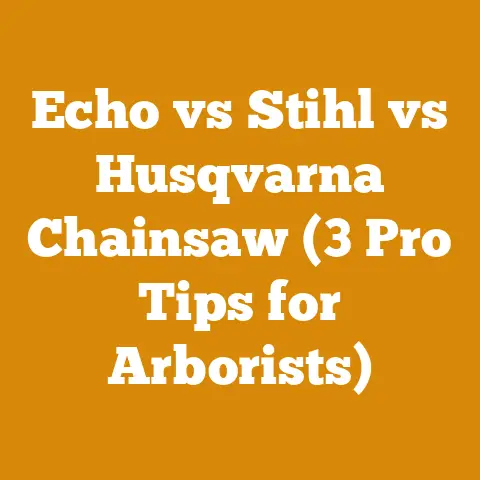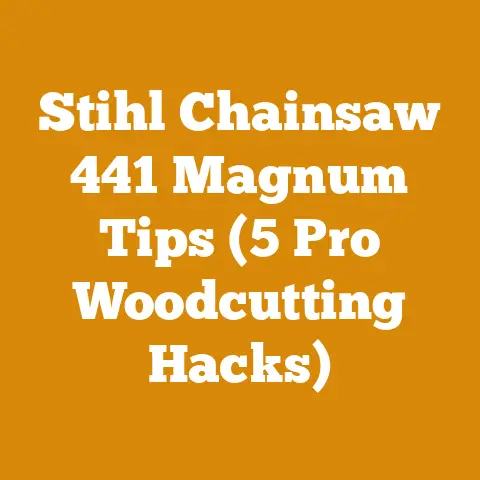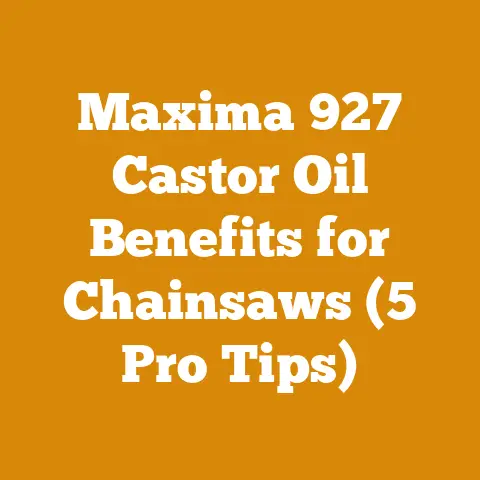How Much Is It to Grind a Stump? (5 Pro Logging Tips)
It’s a staggering statistic: Over 50% of homeowners who attempt tree removal or stump grinding themselves end up regretting it, often due to injury or property damage. That’s a gamble I wouldn’t take, and that’s why you’re here – to understand the true cost of stump grinding, and how to get it done right.
I’ve spent the better part of three decades in the woods, from felling towering pines to splitting cords of oak for winter warmth. I’ve seen firsthand the consequences of underestimating the power of nature and the importance of having the right tools and knowledge. Grinding a stump might seem straightforward, but it’s a task fraught with hidden dangers and potential pitfalls. So, let’s dive into the real cost of vanquishing those stubborn stumps, and I’ll share my top pro logging tips to ensure you come out on top.
How Much Is It to Grind a Stump? Unearthing the True Costs
Understanding the cost of stump grinding goes beyond just the initial quote. It’s about factoring in all the variables and making an informed decision.
The Stump Grinding Cost Equation: A Deep Dive
The price to grind a stump is rarely a fixed number. It’s a dynamic figure influenced by several key factors. I like to think of it as a bit of a puzzle, where each piece contributes to the final picture. Let’s break down the main components:
-
Stump Size: This is the most obvious cost driver. Larger stumps require more time and effort to grind, consuming more machine wear and tear.
- Small Stumps (Under 12 inches in diameter): Expect to pay around \$80 – \$150.
- Medium Stumps (12-24 inches in diameter): Prices typically range from \$150 – \$350.
- Large Stumps (24-36 inches in diameter): Costs can escalate to \$350 – \$600 or more.
- Extra Large Stumps (Over 36 inches in diameter): These behemoths can easily cost \$600+, and sometimes even exceed \$1000, depending on their size and complexity.
-
Stump Quantity: If you have multiple stumps, many companies offer discounts for grinding them all in one visit. This can significantly reduce the overall cost per stump. I’ve personally negotiated package deals where the price per stump dropped by 20-30% when dealing with several stumps on a single property.
-
Stump Location and Accessibility: A stump located in an open field is much easier (and cheaper) to grind than one nestled against a fence or buried in a thicket of roots. Accessibility for the grinding machine is crucial. Obstacles like fences, narrow gates, or steep slopes can increase the labor involved and, therefore, the price. I remember one job where I had to winch a stump grinder over a muddy embankment – that added a good \$150 to the final bill!
-
Stump Age and Wood Type: Older, more decomposed stumps can be easier to grind, while freshly cut stumps, especially those from dense hardwoods like oak or maple, will require more effort and can wear down the grinder teeth faster. Pine stumps, while softer, can be resinous and sticky, which can also complicate the grinding process.
-
Root System: The extent of the root system can significantly impact the cost. If the roots are extensive and spread far beyond the visible stump, the grinding process will take longer and require more cleanup. Some companies charge extra for grinding lateral roots, so be sure to clarify this in your initial quote.
-
Debris Removal: Some companies include debris removal in their price, while others charge extra. This can be a significant cost if you have a large stump or multiple stumps. Debris removal can include hauling away the ground-up stump material (mulch) as well as any rocks, roots, or other debris uncovered during the grinding process.
-
Permits and Regulations: In some areas, you may need a permit to grind a stump, especially if it’s located near a public right-of-way or utility line. Check with your local municipality to see if any permits are required and factor the cost of these permits into your budget.
-
Travel Fees: If you live in a rural area, the stump grinding company may charge a travel fee to cover their transportation costs. Be sure to ask about travel fees when getting a quote.
-
Minimum Charges: Many stump grinding companies have a minimum charge, regardless of the size or number of stumps. This is to cover their overhead costs, such as fuel, insurance, and equipment maintenance. Be sure to ask about the minimum charge before hiring a company.
-
Insurance and Licensing: Always ensure the stump grinding company is properly insured and licensed. This protects you from liability in case of accidents or property damage. Ask for proof of insurance and licensing before hiring a company.
DIY vs. Professional Stump Grinding: A Tale of Two Approaches
You might be tempted to rent a stump grinder and tackle the job yourself. While this can save you money upfront, it’s crucial to weigh the pros and cons carefully.
DIY Stump Grinding: The Appeal of Savings
- Cost Savings: Renting a stump grinder can be significantly cheaper than hiring a professional, especially for small to medium-sized stumps. Rental rates typically range from \$100 – \$300 per day, depending on the size and type of grinder.
- Control: You have complete control over the process and can work at your own pace.
- Flexibility: You can grind the stump whenever it’s convenient for you, without having to schedule an appointment with a professional.
The Risks of DIY: More Than Meets the Eye
- Safety Hazards: Stump grinders are powerful machines with sharp, rotating blades. They can be dangerous if not operated properly. It’s crucial to wear appropriate safety gear, including eye protection, hearing protection, and heavy gloves. I’ve seen firsthand the injuries that can result from improper use, and trust me, it’s not worth the risk.
- Physical Demands: Stump grinding is physically demanding work. It requires strength, stamina, and coordination. You’ll be operating a heavy machine in potentially awkward positions, and you’ll need to be able to control it safely and effectively.
- Equipment Damage: Improper use of a stump grinder can damage the machine and potentially injure yourself or others. You’ll be responsible for any damage to the rental equipment, so it’s crucial to read the instructions carefully and operate the machine according to the manufacturer’s recommendations.
- Hidden Obstacles: Underground rocks, roots, and utility lines can damage the stump grinder and create safety hazards. It’s crucial to thoroughly inspect the area around the stump before grinding to identify any potential obstacles. Call 811 before you dig to locate underground utilities.
- Time Commitment: Stump grinding can take longer than you expect, especially if you’re not experienced. You’ll need to factor in the time it takes to rent the machine, transport it to your property, grind the stump, and clean up the debris.
- Potential for Property Damage: If you’re not careful, you can damage your lawn, landscaping, or other property while grinding the stump. It’s crucial to protect the surrounding area with tarps or plywood.
Professional Stump Grinding: Expertise and Peace of Mind
- Experience and Expertise: Professional stump grinders have the experience and expertise to safely and efficiently grind stumps of all sizes and types. They know how to operate the equipment properly and how to avoid potential hazards.
- Safety: Professional stump grinders are trained in safety procedures and use appropriate safety equipment. They’re also insured, which protects you from liability in case of accidents or property damage.
- Efficiency: Professional stump grinders can grind stumps much faster than you can, saving you time and effort.
- Equipment: Professional stump grinders have access to a wide range of equipment, including stump grinders of various sizes and power levels. They can choose the right equipment for the job, ensuring that it’s done efficiently and effectively.
- Cleanup: Professional stump grinders typically include debris removal in their price, saving you the hassle of cleaning up the mess.
- Convenience: Hiring a professional stump grinder is convenient and hassle-free. You simply schedule an appointment, and they take care of everything else.
My Recommendation: Unless you’re an experienced operator with a strong understanding of safety procedures, I highly recommend hiring a professional stump grinder. The cost is often worth the peace of mind and the assurance that the job will be done safely and efficiently. I’ve seen too many DIY stump grinding projects go wrong, resulting in injuries, property damage, and unexpected costs.
Hidden Costs: The Stump Grinding Surprises
Beyond the obvious factors, several hidden costs can creep into your stump grinding project. Being aware of these potential expenses can help you avoid unpleasant surprises.
- Root Removal: Some companies charge extra for removing large lateral roots that extend beyond the stump. Be sure to clarify whether root removal is included in the price or if it’s an additional charge.
- Rock Removal: If the stump is located in an area with rocky soil, the stump grinding company may charge extra for removing rocks that are encountered during the grinding process.
- Underground Utilities: Hitting an underground utility line can be a costly and dangerous mistake. Always call 811 before you dig to locate underground utilities. If the stump is located near a utility line, the stump grinding company may need to use special techniques to avoid damaging the line, which can increase the cost.
- Soil Amendment: After the stump is ground, you may need to amend the soil to make it suitable for planting grass or other vegetation. This can involve adding topsoil, compost, or other soil amendments.
- Re-Grinding: In some cases, the initial grinding may not be sufficient to remove the entire stump. You may need to hire the stump grinding company to come back and re-grind the stump, which will incur an additional cost.
- Stump Poisoning: Some people choose to poison the stump before grinding it to kill the roots and prevent regrowth. However, this can add to the overall cost of the project, as you’ll need to purchase the stump poison and apply it according to the manufacturer’s instructions. Stump poisoning can take several weeks or months to be effective. I’ve found that physical removal is often the faster and more reliable option.
Getting an Accurate Quote: Asking the Right Questions
To get an accurate quote for stump grinding, be sure to ask the following questions:
- What is your price per stump, and what factors influence the price?
- Do you offer discounts for multiple stumps?
- Is debris removal included in the price?
- Do you charge extra for root removal or rock removal?
- Are you insured and licensed?
- What is your minimum charge?
- Do you charge travel fees?
- What is your payment policy?
- Can you provide references from past customers?
Real-World Cost Scenarios: Learning from Experience
Let’s look at a few real-world scenarios to illustrate the range of costs you might encounter:
- Scenario 1: Small Stump, Easy Access: A homeowner in a suburban neighborhood has a small pine stump (10 inches in diameter) in their front yard. The stump is easily accessible, and there are no obstacles. The homeowner gets a quote for \$90, including debris removal.
- Scenario 2: Medium Stump, Limited Access: A homeowner in a rural area has a medium-sized oak stump (18 inches in diameter) in their backyard. The stump is located near a fence and requires the stump grinding company to use a smaller machine. The homeowner gets a quote for \$300, including debris removal and a travel fee.
- Scenario 3: Large Stump, Extensive Roots: A homeowner in a wooded area has a large maple stump (30 inches in diameter) in their backyard. The stump has extensive roots that extend far beyond the visible stump. The homeowner gets a quote for \$500, including debris removal and root removal.
5 Pro Logging Tips for Stump Grinding Success
Now that you have a better understanding of the costs involved, let’s move on to my top 5 pro logging tips for ensuring a successful stump grinding project. These tips are based on my years of experience in the woods and are designed to help you avoid common pitfalls and get the best possible results.
Tip #1: Preparation is Key: Clearing the Area
Before the stump grinder arrives, take the time to clear the area around the stump. Remove any rocks, debris, or vegetation that could interfere with the grinding process. This will not only make the job easier for the stump grinder but also reduce the risk of damage to the machine or injury to the operator. I always tell my crew, “A clean worksite is a safe worksite.”
- Remove Surface Debris: Clear away any loose rocks, branches, leaves, or other debris from within a 5-10 foot radius of the stump.
- Cut Back Vegetation: Trim back any overhanging branches or bushes that could get in the way of the stump grinder.
- Mark Underground Utilities: Call 811 before you dig to locate underground utilities. Mark the location of any utility lines with flags or paint to avoid accidentally damaging them during the grinding process.
- Protect Surrounding Structures: Cover any nearby structures, such as fences, sheds, or patios, with tarps or plywood to protect them from flying debris.
Tip #2: Understanding Your Stump Grinder Options
Stump grinders come in various sizes and configurations, each suited for different types of stumps and terrain. Understanding the different options can help you choose the right machine for the job.
- Walk-Behind Stump Grinders: These are the most common type of stump grinder and are suitable for small to medium-sized stumps in easily accessible areas. They are relatively easy to operate and maneuver, making them a good choice for DIY projects.
- Tow-Behind Stump Grinders: These grinders are towed behind a truck or tractor and are suitable for larger stumps and more challenging terrain. They are more powerful than walk-behind grinders but also more difficult to maneuver.
- Self-Propelled Stump Grinders: These grinders are self-propelled and have tracks or wheels that allow them to navigate rough terrain. They are ideal for large stumps in hard-to-reach areas.
- Hydraulic Stump Grinders: These grinders use hydraulic power to drive the grinding wheel. They are more powerful and efficient than gas-powered grinders and are often used by professional stump grinding companies.
Choosing the Right Grinder: The size of the stump is the primary factor in determining the right grinder. However, accessibility, terrain, and your experience level should also be considered. For small stumps in easily accessible areas, a walk-behind grinder is usually sufficient. For larger stumps or more challenging terrain, a tow-behind or self-propelled grinder may be necessary.
Tip #3: Mastering the Grinding Technique: A Step-by-Step Approach
Grinding a stump is not just about pointing the machine and letting it rip. It requires a methodical approach and a steady hand. Here’s my step-by-step guide to mastering the grinding technique:
- Position the Grinder: Position the stump grinder so that the grinding wheel is centered over the stump. Make sure the machine is stable and level.
- Engage the Grinding Wheel: Start the engine and engage the grinding wheel. Slowly lower the wheel onto the stump, taking small bites at a time.
- Sweep Back and Forth: Sweep the grinding wheel back and forth across the stump, gradually lowering it deeper with each pass. Overlap each pass slightly to ensure that the entire stump is ground down.
- Grind Below Ground Level: Continue grinding until the stump is at least 4-6 inches below ground level. This will allow you to cover the area with topsoil and plant grass or other vegetation.
- Grind Lateral Roots: Once the main stump is ground down, grind any large lateral roots that extend beyond the stump.
- Clear Debris: Use a shovel or rake to clear away the ground-up stump material (mulch). You can use this mulch as a soil amendment or dispose of it as yard waste.
Pro Tip: Avoid grinding too aggressively, as this can damage the grinding wheel and cause the machine to vibrate excessively. Take your time and let the machine do the work.
Tip #4: Safety First: Protecting Yourself and Others
Stump grinding is a potentially dangerous activity. It’s crucial to take safety precautions to protect yourself and others from injury.
-
Wear Safety Gear: Always wear appropriate safety gear, including:
- Eye Protection: Safety glasses or a face shield to protect your eyes from flying debris.
- Hearing Protection: Earplugs or earmuffs to protect your hearing from the loud noise of the grinder.
- Heavy Gloves: To protect your hands from cuts and abrasions.
- Long Pants and Long Sleeves: To protect your skin from flying debris.
- Steel-Toed Boots: To protect your feet from injury.
- Keep Bystanders Away: Keep bystanders, especially children and pets, away from the work area. Establish a safety zone of at least 25 feet around the stump grinder.
- Be Aware of Your Surroundings: Pay attention to your surroundings and be aware of any potential hazards, such as underground utilities, rocks, or uneven terrain.
- Never Operate the Grinder Under the Influence: Never operate a stump grinder if you are under the influence of alcohol or drugs.
- Read the Operator’s Manual: Before operating a stump grinder, read the operator’s manual carefully and follow all safety instructions.
Tip #5: Debris Management: Cleaning Up the Mess
Stump grinding generates a significant amount of debris, including wood chips, soil, and rocks. Proper debris management is essential for a successful project.
- Collect the Debris: Use a shovel or rake to collect the ground-up stump material (mulch).
-
Dispose of the Debris: You can dispose of the debris in several ways:
- Use it as a Soil Amendment: The mulch can be used as a soil amendment in your garden or flower beds. It will help to improve soil drainage, retain moisture, and suppress weeds.
- Compost it: The mulch can be composted along with other yard waste.
- Dispose of it as Yard Waste: You can dispose of the mulch as yard waste through your local waste management service.
- Fill the Hole: You can use the mulch to fill the hole left by the stump. Mix the mulch with topsoil to create a suitable planting medium.
-
Level the Area: After the debris is removed, level the area with topsoil and compact it with a tamper.
- Seed or Sod: Seed or sod the area to restore the lawn.
Pro Tip: Avoid piling the mulch against the foundation of your house, as this can attract termites and other pests.
Case Studies: Stump Grinding Success Stories
Let’s take a look at a few case studies to illustrate how these tips can be applied in real-world situations:
Case Study 1: The Suburban Stumper
A homeowner in a suburban neighborhood had a small pine stump (10 inches in diameter) in their front yard. They decided to hire a professional stump grinder. The stump grinding company arrived on time and quickly cleared the area around the stump. They used a walk-behind stump grinder to grind the stump down to 6 inches below ground level. They then removed the debris and leveled the area with topsoil. The entire process took less than an hour, and the homeowner was very satisfied with the results. The cost was \$90, including debris removal.
Case Study 2: The Rural Rooter
A homeowner in a rural area had a medium-sized oak stump (18 inches in diameter) in their backyard. The stump was located near a fence and required the stump grinding company to use a smaller machine. The stump grinding company arrived on time and carefully maneuvered the machine into position. They used a tow-behind stump grinder to grind the stump down to 6 inches below ground level. They also ground the large lateral roots that extended beyond the stump. The entire process took about two hours, and the homeowner was very satisfied with the results. The cost was \$300, including debris removal and a travel fee.
Case Study 3: The Wooded Wonder
A homeowner in a wooded area had a large maple stump (30 inches in diameter) in their backyard. The stump had extensive roots that extended far beyond the visible stump. The homeowner decided to hire a professional stump grinder. The stump grinding company arrived on time and used a self-propelled stump grinder to grind the stump down to 6 inches below ground level. They also ground the extensive roots that extended beyond the stump. The entire process took about four hours, and the homeowner was very satisfied with the results. The cost was \$500, including debris removal and root removal.
Budgeting for Stump Grinding: A Practical Guide
Creating a budget for your stump grinding project is essential for avoiding unexpected expenses. Here’s a practical guide to help you estimate the costs involved:
- Assess the Stumps: Determine the size, quantity, and location of the stumps you need to grind.
- Get Multiple Quotes: Contact several stump grinding companies and get quotes for the project. Be sure to ask about all the factors that could influence the price, such as debris removal, root removal, and travel fees.
- Factor in Hidden Costs: Be aware of potential hidden costs, such as rock removal, underground utilities, and soil amendment.
- Consider DIY vs. Professional: Weigh the pros and cons of DIY stump grinding versus hiring a professional.
- Create a Budget: Create a budget that includes all the estimated costs, plus a contingency fund for unexpected expenses.
Example Budget:
- Stump Grinding (3 stumps): \$600
- Debris Removal: \$100
- Root Removal: \$50
- Travel Fee: \$50
- Soil Amendment: \$50
- Contingency Fund: \$100
- Total Budget: \$950
Troubleshooting: Common Pitfalls and How to Avoid Them
Even with careful planning and execution, stump grinding projects can encounter unexpected challenges. Here are some common pitfalls and how to avoid them:
- Get Quotes: Contact several stump grinding companies in your area and get quotes for your project.
- Choose a Stump Grinder: If you’re planning to rent a stump grinder, choose the right machine for the job based on the size and location of the stumps.
- Gather Safety Gear: Purchase or rent the necessary safety gear, including eye protection, hearing protection, heavy gloves, long pants, long sleeves, and steel-toed boots.
- Prepare the Area: Clear the area around the stumps and mark underground utilities.
- Grind the Stumps: Follow the step-by-step grinding technique outlined in this guide.
- Manage the Debris: Collect and dispose of the debris properly.
- Restore the Lawn: Level the area with topsoil and seed or sod the lawn.
Additional Resources:






